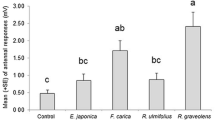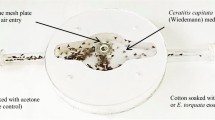Abstract
A series of experiments were conducted to evaluate the toxicity of lemon peel extracts incorporated into mediterranean fruit fly Ceratitis capitata diet. Extracts were obtained with different solvents: diethyl ether, ethyl acetate, and methanol. All three extracts were toxic to some extent; the diethyl ether extract was selected for further studies. Ether extracts of lemon peel were prepared weekly over a 2-month period, from fruits collected on the 1st d of the bioassay. Weekly GC-MS and UV analyses of the extracts demonstrated that the concentration of citral and coumarins decreased in the peel after harvest. We conducted a series of bioassays to evaluate the toxicity of the ether extract, and mixtures of this extract with citral, 5,7-dimethoxycoumarin, and linalool incorporated to C. capitata larvae's natural diet (lemon slices endocarp) at a concentration of 250 μg/g of diet. Significant larvicidal activity can be obtained from a fresh lemon peel extract; however, when the extract was obtained from stored lemons, toxicity decreased. Addition of small amounts of citral or 5,7-dimethoxy- coumarin, and linalool to the stored lemon peel extract would bring back the toxicity to the rates of fresh lemons extracts. Finally, female adults of C. capitata fed on diets containing additional amounts of ether extract, 5,7-dimethoxycoumarin, and linalool, were exposed to different photoperiods to test for phototoxicity. The treatment was toxic and affected the oviposition capacity of females depending on photoperiod.
Similar content being viewed by others
REFERENCES
Ashwood-Smith, M. J., Poulton, G. A., and Liu, M. 1983. Photobiological activity of 5,7-dimethoxycoumarin. Experientia 39:262–264.
Assabgui, R., Lorenzetti, F., Terradot, L., Regnaut-Roger, C., Malo, N., Wiriyachitra, P., Sanchez-Vindas, P. E., San Roman, L., Isman, M. B., Durst, T., and Arnason, J. T. 1997. Efficacy of botanicals from the Meliaceae and Piperaceae, pp. 38–48, in P. A. Hedin, R. M. Hollingworth, E. P. Masler, J. Miyamoto, and D. G. Thompson (eds.), Phytochemicals for Pest Control. CS Symposium Series 658, Washington, DC.
Back, E. A. and Pemberton, C. E. 1918. The Mediterranean fruit fly in Hawaii. U.S. Dep. Agric. Bull. 640:1–43.
Bardón, A., Popich, S., Álvarez Valdés, D., and Catalán, C. A. N. 1999. Toxic effects of a lactone-containing fraction of Cyrtocymura cincta (Asteraceae) on Sitotroga cerealella (Lepidoptera: Gelechiidae). J. Econ. Entomol. 92:1369–1372.
Berhow, M., Teisserat, B., Kanes, K., and Vandercook, C. 1998. Survey of phenolic compounds produced in Citrus. Tech. Bull. 1856:1–160.
Da Silva Branco, E., Vendramin, J. D., and Denardi, F. 2000. Resistência às Moscas-das-frutas em Fruteiras, pp. 161–167, in A. Malavasi and R. A. Zucchi (eds.). Moscas-das-frutas de Importância Econômica no Brazil. Holos Editora, Riberão Preto, Brazil.
Greany, P. D., Styer, S. C., Davis, P. L. Shaw, P. E., and Chambers, D. L. 1983. Biochemical resistance of citrus to fruit flies. Demonstration and elucidation of resistance to the Caribbean fruit fly, Anastrepha suspensa. Ent. Exp. Appl. 34:40–50.
Marty Klyver, M. B., Dip, J. B., Delfini, A. A., Zossi, S., and Catalán, C. A. N. 1992. Características del aceite esencial de limón producido en Tucumán, año 1992. Anales de Sociedad Argentina para la Investigación de Productos Aromáticos, 13:21–34.
Marty Klyver, M. B., Dip, J. B., Marigliano, R., and Catalán, C. A. N. 2000. Características analíticas de diferentes tipos de aceites de limón. Anales de Sociedad Argentina para la Investigación de Productos Aromáticos, 16:51–56.
Nigg, H. N., Nordby, H. E., Beier, R. C., Dillman, A., Macías, C., and Hansen, R. C. 1993. Phototoxic coumarins in limes. Food Chem. Toxicol. 31:331–335.
Spitler, G. H., Armstrong, J. W., and Couey, H. M. 1984. Mediterranean fruit fly (Diptera: Tephritidae) host status of commercial lemon. J. Econ. Entomol. 77:1441–1444.
Tanaka, N., Okomoto, R., and Chambers, D. L. 1970. Methods of mass rearing Mediterranean fruit fly currently used by the U.S. Department of Agriculture, pp. 19–23, in Proceedings of a Panel on Sterile-Male Technique for Control of Fruit Flies. IAER, Vienna.
Wong, T. T. Y. and Nakahara, L. M. 1978. Sexual development and mating response of laboratory-reared and native Mediterranean fruit flies. Ann. Entomol. Soc. Am. 71:592–596.
Quayle, H. J. 1914. Citrus fruit insects in Mediterranean countries. U.S. Dept. Agric. Bull. 134:1–36.
Quayle, H. J. 1929. The Mediterranean and other fruit flies, Univ. Calif. Exp. Stn. Circ. 315:1–19.
Author information
Authors and Affiliations
Corresponding author
Rights and permissions
About this article
Cite this article
Salvatore, A., Borkosky, S., Willink, E. et al. Toxic Effects of Lemon Peel Constituents on Ceratitis capitata . J Chem Ecol 30, 323–333 (2004). https://doi.org/10.1023/B:JOEC.0000017980.66124.d1
Issue Date:
DOI: https://doi.org/10.1023/B:JOEC.0000017980.66124.d1




